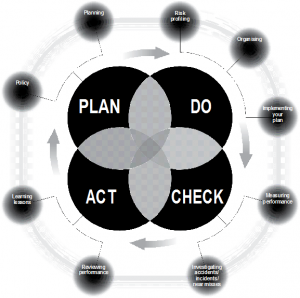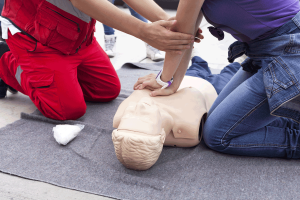Managing for health and safety
This week’s article looks at the HSE’s guide to Managers HSG65. This is mainly for leaders, owners, trustees and line managers. It will particularly help those who need to put in place or oversee their company’s health and safety arrangements.
The advice may also help workers and their representatives
The guidance explains the Plan, Do, Check, Act approach and shows how it can help you achieve a balance between the systems and behavioural aspects of management. It also treats health and safety management as an integral part of good management generally, rather than as a stand-alone system.
We also have our regular pick of this week’s HSE cases which show safety management failings.
This week’s 2 recent HSE case look at:
- Ms Deaney spent a significant amount of time on her mobile phone instead of giving her full attention to Majid while walking with him around the reservoir.
- A worker was struck by an unsecured furniture arm which fell from an unstable load. The impact knocked him unconscious and he suffered serious neck and head injuries.
As ever, if you have a subject that you would like us to cover one week, please contact us by phone 01458 253682, email or via our Facebook page or by Twitter
Managing for health and safety
Businesses have a legal duty to put in place suitable arrangements to manage for health and safety. This article provides a framework to help you do that effectively, in a way that your business can tailor to your own circumstances.
In implementing your arrangements, you should consult with your employees or their representatives, including trade unions where they are recognised.
The framework described in this article is universal but how far action is needed will depend on the size and nature of the organisation, and the risks from its activities, products or services.
The Plan, Do, Check, Act approach
HSE has moved away from using the POPMAR (Policy, Organising, Planning, Measuring performance, Auditing and Review) model of managing health and safety to a ‘Plan, Do, Check, Act’ approach.
The move towards Plan, Do, Check, Act achieves a balance between the systems and behavioural aspects of management. It also treats health and safety management as an integral part of good management generally, rather than as a stand-alone system.
The high-level descriptions may vary, depending on the industry or sector you are working in, but a summary of the actions involved in delivering effective arrangements and how they are frequently described is given in Table 1, under the headings of Plan, Do, Check, Act.
Table 1 The read-across between Plan, Do, Check, Act and other management systems
| Plan, Do, Check, Act | Conventional health and safety management | Process safety | |
| Plan | Determine your policy/Plan for implementation | Define and communicate acceptable performance and resources needed
| |
| Identify and assess risks/Identify controls/Record and maintain process safety knowledge | |||
| Do | Profile risks/Organise for health and safety/Implement your plan | ||
| Implement and manage control measures | |||
| Check | Measure performance (monitor before events, investigate after events) | Measure and review performance/Learn from measurements and findings of investigations | |
| Act | Review performance/Act on lessons learned |
Plan
- Think about where you are now and where you need to be.
- Say what you want to achieve, who will be responsible for what, how you will achieve your aims, and how you will measure your success. You may need to write down this policy and your plan to deliver it.
- Decide how you will measure performance. Think about ways to do this that go beyond looking at accident figures; look for leading indicators as well as lagging indicators. These are also called active and reactive indicators.
- Consider fire and other emergencies. Co-operate with anyone who shares your workplace and co-ordinate plans with them.
- Remember to plan for changes and identify any specific legal requirements that apply to you.
Do
- Identify your risk profile
- Assess the risks, identify what could cause harm in the workplace, who it could harm and how, and what you will do to manage the risk.
- Decide what the priorities are and identify the biggest risks.
- Organise your activities to deliver your plan
In particular, aim to:
- Involve workers and communicate, so that everyone is clear on what is needed and can discuss issues – develop positive attitudes and behaviours.
- Provide adequate resources, including competent advice where needed.
- Implement your plan
- Decide on the preventive and protective measures needed and put them in place.
- Provide the right tools and equipment to do the job and keep them maintained.
- Train and instruct, to ensure everyone is competent to carry out their work.
- Supervise to make sure that arrangements are followed.
Check
- Measure your performance
- Make sure that your plan has been implemented – ‘paperwork’ on its own is not a good performance measure.
- Assess how well the risks are being controlled and if you are achieving your aims. In some circumstances formal audits may be useful.
- Investigate the causes of accidents, incidents or near misses
Act
- Review your performance
- Learn from accidents and incidents, ill-health data, errors and relevant experience, including from other organisations.
- Revisit plans, policy documents and risk assessments to see if they need updating.
- Take action on lessons learned, including from audit and inspection reports
The Plan, Do, Check, Act cycle
Plan, Do, Check, Act should not be seen as a once-and-for-all action:

You may need to go round the cycle more than once, particularly when:
- starting out;
- developing a new process, product or service; or
- implementing any change.
Whatever your industry, or the size or nature of your organisation, the keys to effectively managing for health and safety are:
- leadership and management (including appropriate business processes);
- a trained/skilled workforce;
- an environment where people are trusted and involved.
HSE advocates that all of these elements, underpinned by an understanding of the profile of risks the organisation creates or faces, are needed
Legal duties
All organisations have management processes or arrangements to deal with payroll, personnel issues, finance and quality control – managing health and safety is no different.
The Management of Health and Safety at Work Regulations 1999 require employers to put in place arrangements to control health and safety risks. As a minimum, you should have the processes and procedures required to meet the legal requirements, including:
- a written health and safety policy (if you employ five or more people);
- assessments of the risks to employees, contractors, customers, partners, and any other people who could be affected by your activities – and record the significant findings in writing (if you employ five or more people). Any risk assessment must be ‘suitable and sufficient’;
- arrangements for the effective planning, organisation, control, monitoring and review of the preventive and protective measures that come from risk assessment;
- access to competent health and safety advice, such as The Wilkins Safety Group;
- providing employees with information about the risks in your workplace and how they are protected;
- instruction and training for employees in how to deal with the risks;
- ensuring there is adequate and appropriate supervision in place;
- consulting with employees about their risks at work and current preventive and protective measures.
Leading and managing for health and safety
Leaders, at all levels, need to understand the range of health and safety risks in their part of the organisation and to give proportionate attention to each of them. This applies to the level of detail and effort put into assessing the risks, implementing controls, supervising and monitoring.
If you would like any further help or support, please please contact us by phone 01458 253682, email or via our Facebook page or by Twitter
We are exhibiting in 2017
As part of our 25th anniversary celebrations the Wilkins Safety Group are exhibiting at 3 Business Expos this year in Exeter, Swindon and Bristol.
The first of these is at the South West Business Expo on Thursday 30th March at the Matford Centre, Marsh Barton, Exeter EX2 8FD.
We are Stand 131 whe re you can meet members of our team and discuss your Health & Safety concerns and learn what we can do to takes the worry of dealing with Health & Safety regulations off your hands, leaving you free to concentrate on running your business the way you want to.
re you can meet members of our team and discuss your Health & Safety concerns and learn what we can do to takes the worry of dealing with Health & Safety regulations off your hands, leaving you free to concentrate on running your business the way you want to.
There will also be free to enter Prize Draw
Don’t miss your opportunity to visit over 170 exhibitors, be inspired by many Free Seminars and enjoy many Networking events through-out the Expo from Speed Networking to the Networking Cafe. There will also be Live Cookery Demonstrations with local chefs from restaurants showing off their skills
Training Courses
The first of our courses in 2017 are listed below.
We are also looking to run some short Health and Safety awareness sessions to emphasise the need for improving your H&S procedures.
Also remember we are still available for running “In House” courses and are looking to add new training courses to our list.
If you have any questions about these courses or any other training or would like us to run a particular course for you, call Jon Wilkins of the Wilkins Safety Group on 01458 253682 or email him
First Aid at Work
All employers in the UK have a legal obligation to make first aid provision for their employees. This course is ideal for those who are going to be a nominated  First Aider in the workplace. This 3 day course meets the statutory requirements of the Health & Safety Executive. Candidates must be of a working age and intend to practice first aid in the workplace during the validity of the certificate.
First Aider in the workplace. This 3 day course meets the statutory requirements of the Health & Safety Executive. Candidates must be of a working age and intend to practice first aid in the workplace during the validity of the certificate.
The course duration is 3 days and a certificate of competence lasting three years will be awarded on successful completion of the course.
Updated to cover the control of catastrophic bleeding
SYLLABUS:
- Course introduction.
- Legal compliance.
- Managing incidents.
- Examining a casualty.
- Conscious/unconscious casualties.
- Treating a casualty.
- Further emergency action.
- General common illnesses.
- Basic life support.
- First aid kits/equipment.
- Recording/reporting injuries.
| Course Ref | Date(s) | Location | |
|---|---|---|---|
| 27th, 28th Feb & 1st Mar 2017 | The Corner House Hotel, Park Street, Taunton, Somerset TA1 4DQ |
Re-qualification First Aid at Work
This First Aid at Work Refresher course is designed for anyone who has previously completed the 3 day First Aid at Work qualification and needs to renew their skillset and certification. This refresher lasts 2 days and secures the delegates’ qualification for a further 3 years before the course will need to be retaken.
Updated to cover the control of catastrophic bleeding
SYLLABUS
- Course introduction.
- Legal compliance.
- Managing incidents.
- Examining a casualty.
- Conscious/unconscious casualties.
- Treating a casualty.
- Further emergency action.
- General common illnesses.
- Basic life support.
- First aid kits/equipment.
- Recording/reporting injuries.
Course Duration: 2 Days
| Course Ref | Date(s) | Location | |
|---|---|---|---|
| 28th Feb & 1st Mar 2017 | The Corner House Hotel, Park Street, Taunton, Somerset TA1 4DQ |
Site Manager Safety Training Scheme
(Part of Construction Skills “Site Safety Plus” Suite of Courses)
Target Audience
Site managers, agents and persons who are, or are about to be, responsible for planning, organising, monitoring, controlling or administering groups of staff and workforce.
Aims & Objectives
To help site managers, agents and supervisors to:
- Manage health & safety on site in accordance with current legal provisions, and within the context of their management or supervisory role
- Develop an understanding of responsibilities and accountability for site health, safety and welfare
- Recognise that a safe site is efficient, economical and productive
Delegates will, at the end of the training, be aware of and able to:
- Implement all health, safety, welfare and environmental legislation which affects them during their work
- Implement new guidance and industry best practice
- State their duties and responsibilities with regards to health, safety, welfare and the environment
Course Notes / Assessment / Certification
Candidates will be issued a copy of GE700/16 – Site Safety Simplified and the course study notes.
Candidates will be assessed through 3 Core Exercises and an end of course examination.
Certificates are issued by Construction Skills and are valid for 5 years.
| Date(s) | Location |
|---|---|
| 13th – 15th March inc and 20th & 21st March 2017 | Mendip Vocational Skills Centre, Mendip Business Park, Mendip Road, Rooksbridge, Somerset, BS26 2UG |
CDM Regulations 2015 – An Awareness Course
Course Objective: Training /CPD and APS Certificates
The Construction (Design and Management) Regulations 2015 (CDM 2015) come into force on the 6th of April 2015, and will apply to all construction projects in the UK incl. Domestic projects
This CDM 2015 awareness training course has been developed to provide all duty holders with an understanding of their role and responsibilities under CDM 2015.
Seminar Outline:
- Introduction to CDM 2015
- Notification
- Client Duties and Domestic Clients
- Principal Designer Duties
- Principal Contractor Duties
- Designer Duties
- Contractor Duties
- CDM Documentation
- Benefits of Attending
These courses give an overview of the requirements for Clients, Principal Designers, Principal Contractors, Contractors, Designers and Workers, and how the regulations apply to construction projects.
An individual who successfully completes this CDM2015 Awareness Course may claim points towards membership of the Association for Project Safety – APS
Course Duration: 1 day
| Course Ref | Date(s) | Location |
|---|---|---|
| CDM2015 1701 | Monday 13th March 2017 | Taunton Racecourse, Orchard Portman, Taunton, Somerset TA3 7BL |
ASBESTOS AWARENESS – Half-Day Course
Course Objective – Training /CPD Certificate issued
Asbestos awareness training is essential for employees whose work holds the potential to expose them to asbestos. The Control of Asbestos Regulations 2012 puts a requirement on employers to ensure that their staff have undergone suitable asbestos awareness training so that they are aware of the potential dangers they may face and also the procedures they must follow in the event they are working in the vicinity of asbestos containing materials (ACMs)
Who Is This Course Suitable For?
The main groups of workers that are deemed to be at risk from asbestos exposure and therefore the groups’ most requiring asbestos awareness training are as follows:
- General Maintenance Staff.
- Electricians, Plumbers & Gas Fitters. Painters & Decorators.
- Construction & Demolition Workers. Joiners and Plasterers.
- Computing & Telecommunications Engineers.
- Heating & Ventilation Engineers.
- Roofers.
- Architects & Building Surveyors
- Fire & Burglar Alarm Installers
Syllabus
- Asbestos- a history of use
- What is Asbestos
- Amosite (Brown) – Chrysotile (White) – Crocidolite (Blue)
- Asbestos Containing Product Examples
- Asbestos Properties and the hidden legacy of asbestos
| Course Ref | Date(s) | Location |
|---|---|---|
| ASBESTA 1701 | Wednesday 22nd March 2017 | Taunton Racecourse, Orchard Portman, Taunton, Somerset TA3 7BL |
